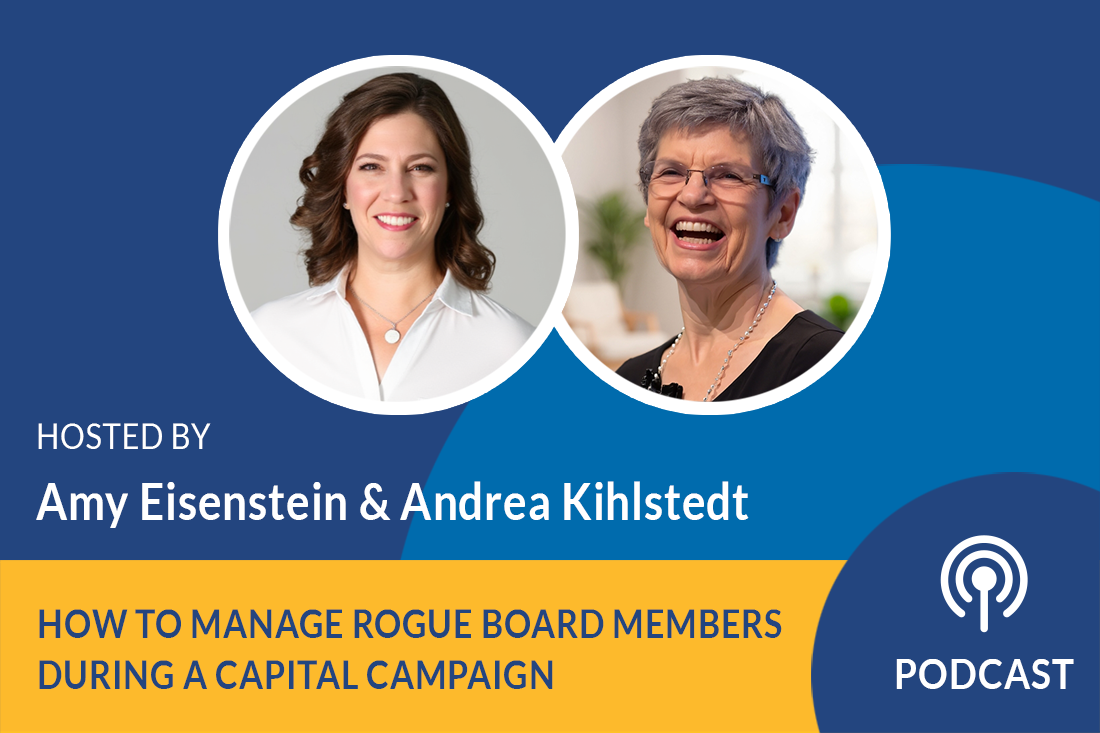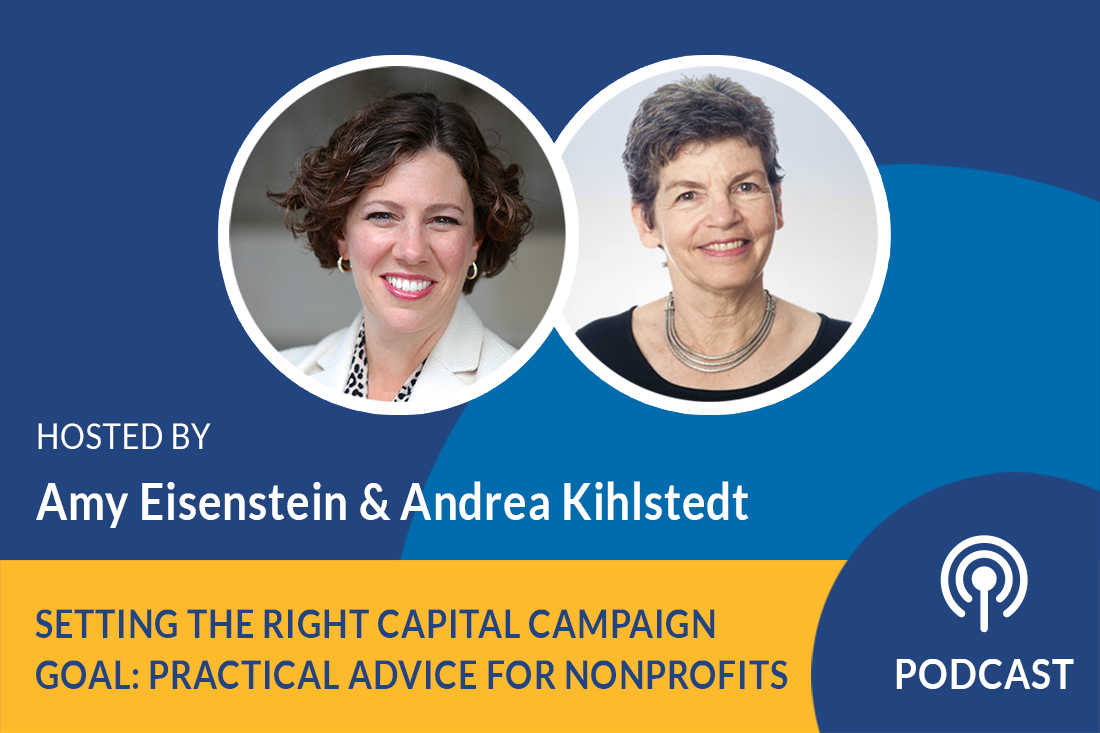Podcast: Gap Funding Campaigns: Responding Effectively to Government Cuts

Season 4, Episode 38
In this episode, Amy Eisenstein and Andrea Kihlstedt tackle a pressing challenge faced by many nonprofit organizations: managing unexpected government funding cuts. They explore strategies for launching a successful gap funding campaign, a targeted approach to securing crucial short-term donations to sustain vital programs.
Listen now to ensure your nonprofit is prepared to handle funding uncertainties with confidence and clarity.
Listen Now:
Stream the episode above, or click here to find it on Spotify. You can also find all episodes on your favorite streaming platform.
Amy Eisenstein:
Many organizations are concerned about government cuts and the implications for their programs and services. If that resonates for you, listen up.
Hi, I’m Amy Eisenstein. I’m here with my colleague and co-founder of Capital Campaign Pro, Andrea Kihlstedt, and today we are talking about what is probably on your mind, the government cuts to nonprofits, to programs to services that are near and dear to our hearts. So we’re going to talk about how to think about that, what you might be doing in the context of a gap funding campaign.
So Andrea, why don’t you set the stage, as you always do so well, about how nonprofits today can be thinking about any government cuts that they’ve already received or that they might be concerned about and that might be coming down the pike.
Gap Funding for Your Nonprofit: Do it Carefully
Andrea Kihlstedt:
So Amy, we are going to talk today about a very specific kind of government cuts. This is not going to be a program about organizations that are fully funded by the government and what to do about it. This is for organizations that have some private philanthropy, that have a robust development program and that have some programs that receive government funding, and the worry is that the government funding is being or will be cut.
And with that, unless there is a remedy, they’re going to have to lay people off. They have to shut down programs or truncate programs. And the question is what to do about it. Now, what’s complicated, in normal times, we generally separate quite clearly annual operating budgets from special campaigns or capital campaigns or capacity campaigns where you raise money that is over and above.
This gap funding is a situation where those things get perilously close. Where what you’re going to be funding, actually… Let’s say, to make this specific, that your organization has a $100,000 program and you have just heard that it’s going to be cut. And that means that by September you will have to shut the program down unless you can figure out another way to fund it.
Now, program funds are recurring, right? This is going to go on year after year after year, which is a situation that makes it difficult to raise from a special campaign. It makes it appropriate for annual fundraising where people give to you and expect to renew their gift year after year. But here we have a special circumstance and I think a real opportunity to go to the donors who are closest to you and ask them to help you fund the gap.
[Your donors will] help you fill in the gap. Now, you have to do it in a specific and careful way, and that’s what we plan to give you some clarity about today.
Amy Eisenstein:
So let me just back up for a second and add that the reason that it’s a little different or potentially more complicated is because, normally, when we talk about capital campaign fundraising or capacity campaign fundraising, we’re talking about one-time special needs, special donations that are over and above the annual fund.
But with these government cuts and these ongoing programs and services, we’re asking donors to give to something that is going to need ongoing funding. So I just wanted to clarify that a little bit in case it wasn’t clear enough. So that’s the problem it potentially poses with doing a special campaign style effort of fundraising, but I think we have some good suggestions to overcome that.
Andrea Kihlstedt:
It’s funny how when things go south, go bad or may be going bad, there are almost always opportunities, and this is one of those opportunities. Now, the reason it’s an opportunity is because this is based on a situation that pretty much everyone knows about. This is not just a situation for your organization that is going to for some reason lose a grant. That’s one kind of situation.
But what’s happening is that many grants are being cut for nonprofits all over the place. And generally, the people around the country know, they have an inkling of what’s going on, and if you are communicating well to your donors, they may already know that you’re concerned or that you have received notice, but it is in a bigger context of a larger change that’s happening.
Amy Eisenstein:
So people have more than an inkling of what’s going on. They’re up in arms about it. Your donors are probably upset at the idea that… Well, some of your donors are hopefully upset at the idea that these funds and vital programs and services in your community are being eliminated.
A Real-World Example
Andrea Kihlstedt:
Now, I have a great little example, a little story. As you probably know, we have Wednesday calls for all of our clients. They come to a call. We have have two of our experts working with small groups every Wednesday for two different sessions. And a couple of weeks ago, one of our clients said, “We just heard that one of our programs lost its funding and it’s going to cause problems.” And she said, “When that came out, I got a call from one of our donors saying, ‘Is this going to affect your therapists, the therapists who work with the kids? Is it going to be a problem?'”
She said, “Yes, as a matter of fact, it is. If we can’t replace this money, we’re going to have to lay people off and we’re not going to have therapists to work with the kids.” Without blinking, this guy said, “Well, how much does it cost to cover the cost of a therapist for a year?” And she gave him the amount and he said, “I’ll cover the cost of a therapist for you.”
Amy Eisenstein:
Amazing.
Andrea Kihlstedt:
Now, that doesn’t happen all the time. On the other hand, if someone cares about the program, if their kid is perhaps, or someone they know is served by the program and all of a sudden they realize that the cuts are going to affect something close to them, it’s not impossible that somebody would call. And if they don’t call, it’s even quite likely that people are concerned enough to want to help. They may not know how to help, but they may want to help. And that provides a fantastic fundraising opportunity.
Amy Eisenstein:
And actually we’re hearing more and more stories like that. We just heard two stories from our clients last week where donors stepped up to fill the gap. And so we’re working on helping our clients and others be proactive and so that they can take advantage of the moment. I started to hesitate to say take advantage of, but leverage the unfortunate opportunity that’s around you in order to preserve the vital programs that you provide.
What Does a Gap Funding Campaign Look Like?
So let’s talk about this idea of a gap funding campaign, what’s involved, what the pros and cons are. And just as a side note, we are now offering gap campaign services because we’re trying to pivot and meet the need of what’s going on in the sector. So our whole team is now ramping up gap campaigns. So if you think you need one —
Andrea Kihlstedt:
You and I know that every time we start to use the word pivot, there must be some big problem in the world. Right?
Amy Eisenstein:
I choked. I choked on the word. I can’t even say it. So let’s talk about what might be involved or what organizations should start thinking about if they have already lost funding or if they think they might be losing funding in the near future.
A Gap Funding Campaign Differs from a Capital Campaign
Andrea Kihlstedt:
So let me start this way. While it is highly likely that you can launch and execute a successful campaign to raise money to fill the program gap caused by cutbacks in government funding, that does not mean that you will be able to raise private funds that will, over the long haul, support your programs that have been previously covered by government funds. We’re talking two different things here, and you need to think that way.
Then what makes a capital campaign work is that you’re asking donors who give to you in a recurring fashion to give a special gift, as Amy said, that is over and above their recurring gift to fill a special need. But you have to put a plan in front of them that says why you’re not going to be coming back to them year in, year out, forever to support that program. Which means that, while you are working to fill the gap, you also need to be developing a plan for ramping up your other kinds of funding so that you eventually will be able to cover the costs of this program in other ways.
So you have two things going on, and both of them are important to this gap funding, because you need to be able to lay that out to your donors, you need to be able to say:
“We’ve lost $100,000. If we can’t fill that bucket for the next year or two or three, we’re going to have to either cut back or end this program. We really don’t want to do that, but we have developed a plan long-term about how to fund it. It’s just going to take us a while to do that, and we are now raising short-term money to keep the program going in the interim. So we would like you, donor, to help us with this short-term funding to keep the program going.”
Now, that’s a different message, and listen to it, that’s a different message than if you go to the donor and say:
“We’re losing the funds for this program and we’re going to our individual donors to pick up the slack.”
Big difference, right?
Amy Eisenstein:
Yeah. I’m taking a deep breath because it’s going to be hard to ramp up the fundraising. It’s not an easy thing to do, but that is the goal I think.
Andrea Kihlstedt:
It’s always hard, but things change. There are new donors, there are new foundations, there are new opportunities. You may be able to tinker with the program to make it more cost-effective. That would be fantastic also. There are all kinds of things you can do to actually look at that program and say, “Well, is this an opportunity for us to do a better job in a more cost-effective way?” If you can, this is a great time to grab onto that.
So fundraising is never easy, but when things get tossed up in the air, they very often come back stronger. They fall back together in a better pattern. And Amy, you and I work with hundreds of organizations, and very few of them I think actually maximize their funding capacity.
Amy Eisenstein:
I think that’s a good point.
Andrea Kihlstedt:
Very few. They raise what they need to raise. Have they ever said, “Gee, let’s really rethink this. Let’s see how we can raise more money to do more good.”? If you do that effectively, you get used to raising money the way you raise money.
So this is an opportunity to throw things up in the air, but it is based on actually having a campaign to fill the gap and perhaps even invest in capacity building so that you can be raising more money over the long haul as well.
Gap Funding Campaign: The Good News
Amy Eisenstein:
So let me throw in a couple of other suggestions and potentially some other good news.
So one is, as a stopgap, you’re looking to do this gap funding campaign to fill the need in the short term, and I’m talking about 12 to 24 months as the short term. And then at least you’re going to be making contingency plans. And so, what happens if we raise some of the money for the long term?
- What if we raise part of it?
- What if we raise all of it?
- What if we raise none of it?
So that you can go to your donors and ask for this stop gap funding and show them contingency plans and ask for their advice. What do they suggest? So it’s a wonderful opportunity to engage donors.
The other piece of good news is that in the next 12 to 24 months, there is ever going to be more and more technology that actually helps you raise money. And every day there emerges new technology that helps with donor analytics, communication, analysis, writing, the list is endless. And so the landscape of fundraising 24, 48 months from now may be totally different.
And so really, with a gap funding campaign, you’re buying yourself time and you’re maintaining programs and services while you’re figuring out what to do.
Andrea Kihlstedt:
You’re not only buying yourself time, but you have an amazing opportunity to build relationships with people who are already close to you and people who are not yet so close to you. So you really can become very proactive in asking people for advice. Amy just mentioned that, but you can have small group meetings to come together to look at various solutions. You can go out and talk to donors individually. There are many things you can do to draw people in and to strengthen those relationships.
The one thing that fits into this is that there’s concern I think that, because things seem so uncertain, that donors aren’t going to want to give or that donors don’t have money. So I want to allay your concern. Now, while it’s true that some people will have less money than they had, there are people who will have at least as much and maybe more money than they had. And if you make a strong case and you engage people in your organization, you may well increase their interest and willingness to make significant gifts to you.
So don’t go about this with the, “Oh, I’m so sorry to be coming to you at this time when the market is doing whatever the market is doing.” There are people who, every time the market goes down, there are people who are making money, and every time the market goes up, there are people who are making money. So take your mind out of your own bank account and your own finances and understand that people who have serious wealth are largely protected from the vagaries of the stock market.
Amy Eisenstein:
The rich are getting richer. Let’s just call like it is.
Andrea Kihlstedt:
Rich are getting richer, that’s an easy way… That’s a simple —
Amy Eisenstein:
The rich are getting richer.
Andrea Kihlstedt:
Simple way to put it, isn’t it?
Making a Very Specific Case to Donors
Amy Eisenstein:
So how to think about a gap funding campaign [read our 10 steps here], and this is actually what we’re gearing up our team to help organizations with, is developing the case. What is the very specific case that, for your gap funding campaign, that you need right now, thinking about putting together a little committee to create essentially a mini campaign to solicit and to shore up either gap funding and/or a bigger rainy day fund for these times of uncertainty.
So working in campaign style fundraising, working on a gift range chart, working on your pipeline of donors, working to solicit people in ways that you haven’t done before.
So whether you’re in a campaign, a traditional, multi-year capital campaign and you’ve lost funding, or you aren’t in a campaign, but now you need to do one, I’m happy my team has been able to develop this program where we’re going to really be able to help organizations. So I’m feeling good about that. Are you?
Andrea Kihlstedt:
I am. I’m feeling excited about it. I think we really can help organizations, and I think the more organizations really dive into major gifts fundraising, to leadership gift fundraising, the stronger they’re going to be in the future. Those relationships really provide a solid base is so, so important and so exciting, actually.
Amy Eisenstein:
So talk to your team, talk to your leadership team, talk to your board, talk to your colleagues about what you’re going to be doing in terms of filling the gap, filling the need. And if you want to talk to us about how we can support you through, we’re here to do that as well.
So thanks for listening and we’ll see you next time. Bye for now.



Leave a Comment